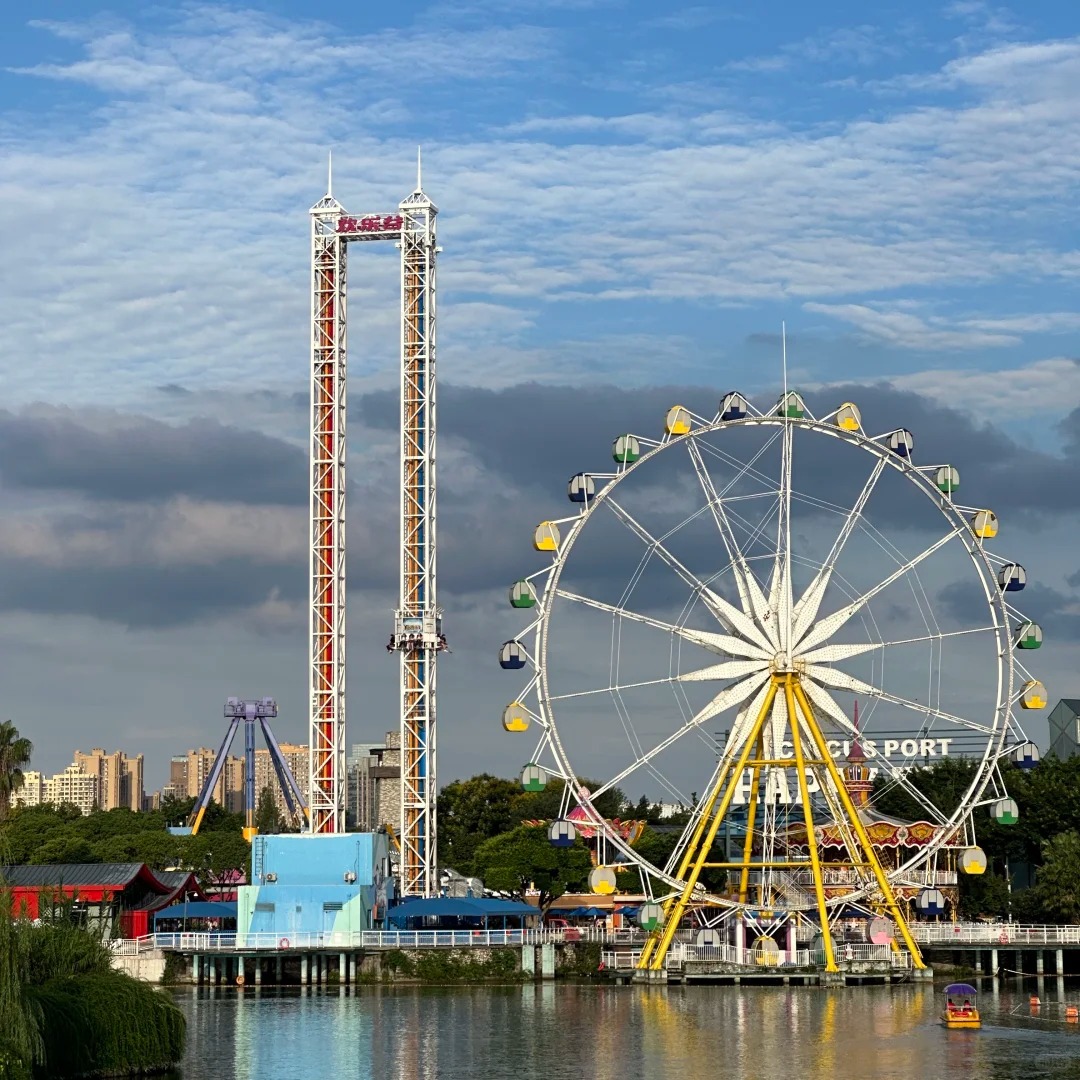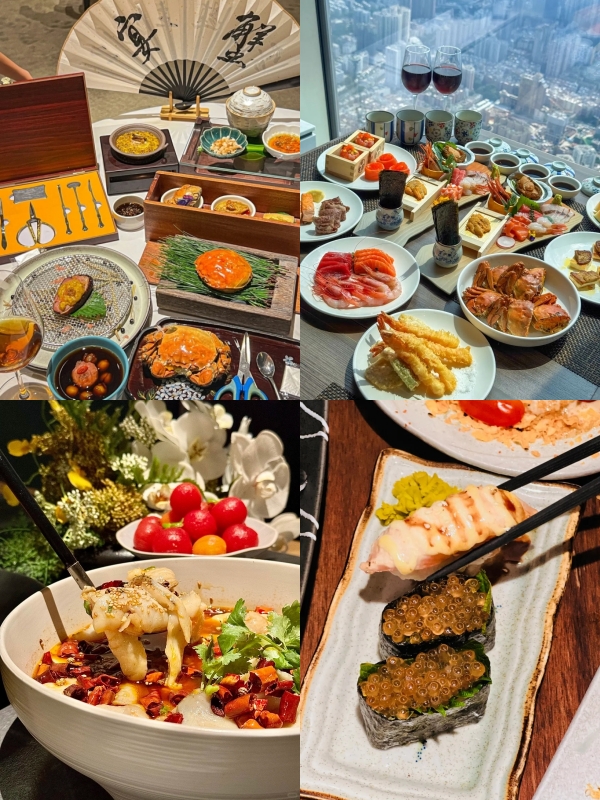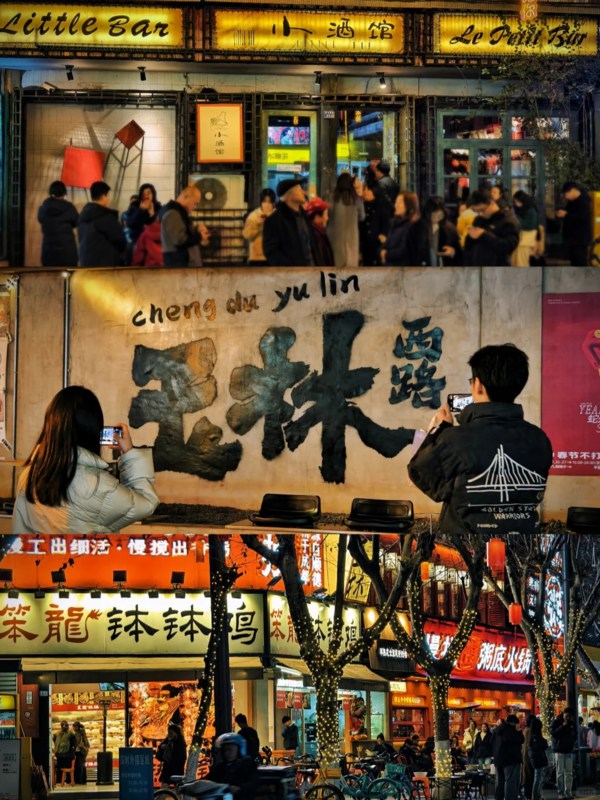Dunhuang, China historical sites aren’t just relics—they’re alive with desert wind, monk-painted murals, and silent fortresses that still whisper stories. If you’re heading to China’s ancient Silk Road outpost, this isn’t just a checklist of attractions—it’s a guide to feeling the dust, dodging the tour buses, and knowing which dried raisins are actually worth bringing home.
From the shadowed stillness inside Mogao’s thousand-year-old caves to the quiet thrum of wind across Yumen Pass, Dunhuang surprised me in ways no brochure prepared me for. This guide breaks down what it’s really like to explore Dunhuang’s cultural layers—from booking tickets without speaking Chinese, to eating noodles under a night market lantern, to handling checkpoints that feel a little too official. If you’re planning to visit Dunhuang’s historical sites, you’ll want to read this before you pack your scarf, sunscreen, and a pocketful of small bills.
Planning a bigger trip? Here’s our full guide to China’s top historical sites.
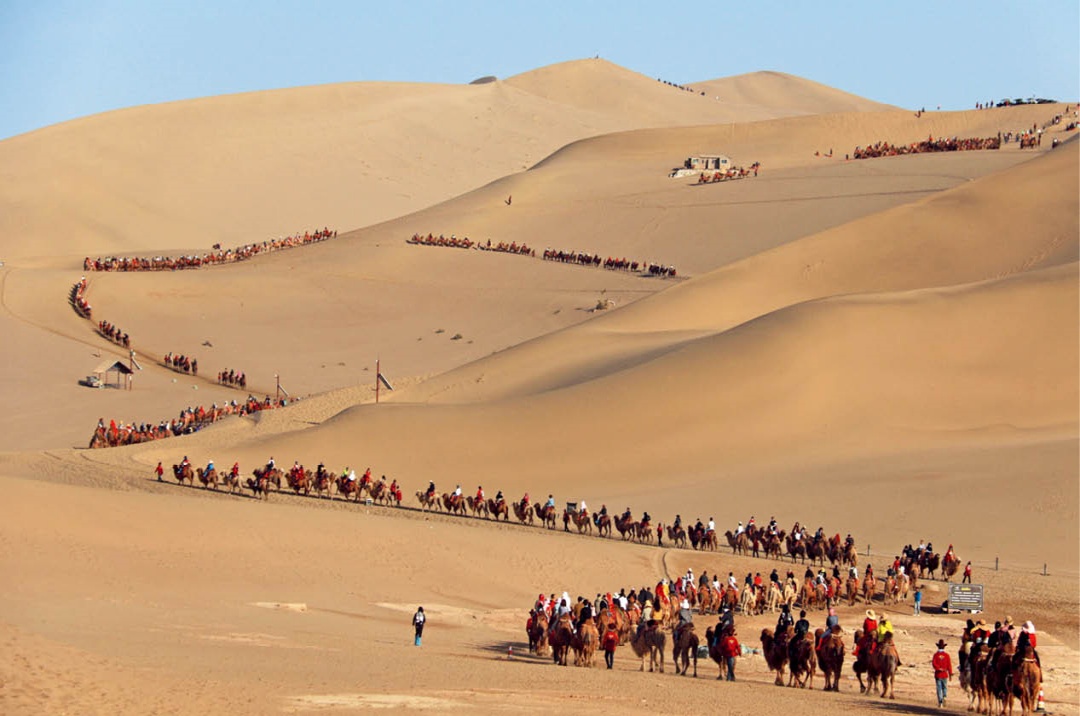
Dunhuang murals
The First Time I Saw Dunhuang—And Why It Felt Familiar
I didn’t know what to expect when I landed at Dunhuang Airport. It’s not much more than a regional terminal, and the desert heat doesn’t creep up on you—it smacks you right in the face. It’s not humid, just dry and sharp, with air that smells faintly of sun-baked dust and wind-polished stone. Oddly, the place looked familiar, not in a “have I been here before?” way, but more like stepping into a half-remembered painting of camel caravans and Buddhist monks from some school textbook or museum exhibit. It didn’t feel constructed—it just was.
The city itself isn’t large. There’s a kind of softness to the pace—no honking, no flashy lights. I stayed at a place called Tianrun Xiangcheng, right on the edge of the tourist zone. It wasn’t luxury, but it did the job and accepted foreign passports. I picked it because it was close to the Mogao ticket office, but even that lobby had this faint scent of age—wood, paper, heat. You’d see little things everywhere: calligraphy murals on dumpling shop walls, faded arrows pointing “to the ancient trade route” (according to a raisin vendor), and alleys that seemed to fold back into themselves like the layers of a scroll. Nothing screamed “heritage”; it was quieter than that.
That doesn’t mean Dunhuang is empty. Far from it. During my stay, at least seven tour buses parked outside my hotel one morning, engines running while passengers queued in sunhats and photo vests. But if you’re willing to walk past the obvious, the tone shifts. At Mingsha Dunes, for example, beyond the camel-riding zone, there’s a silent slope where you can actually hear the sand sing. It’s a low, buzzing hum—almost like static. I took off my shoes and sat there, the wind flicking grains at my ankles, and for a few minutes, everything went still. Not countryside still—museum still. And that stillness was the first moment I really felt Dunhuang.
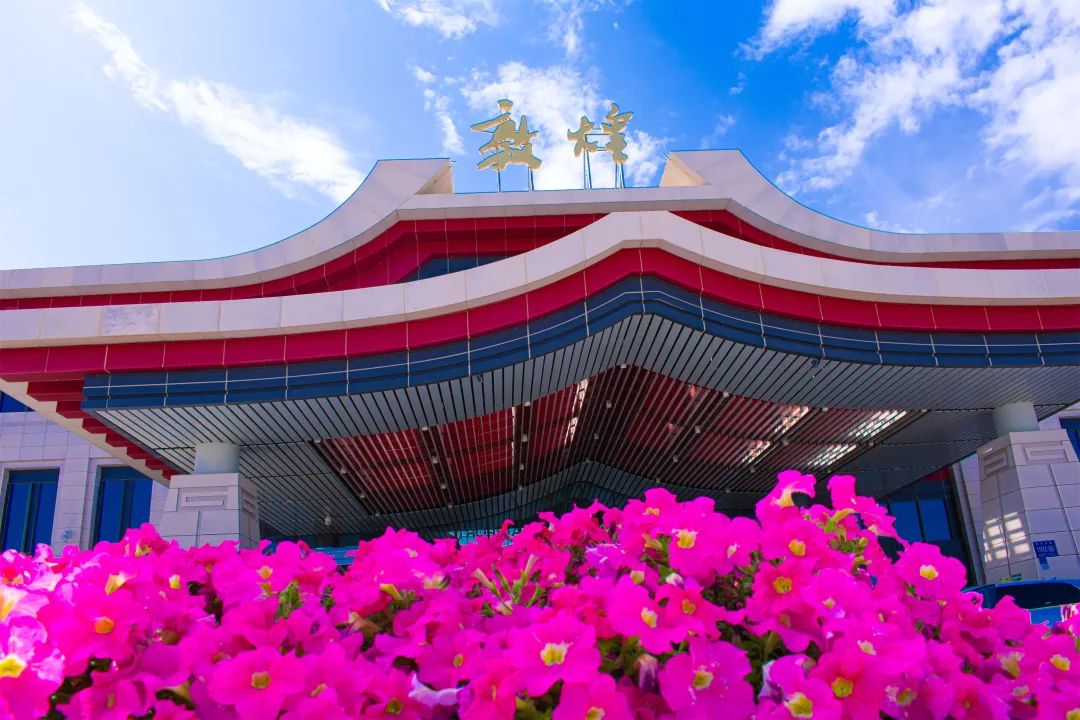
Dunhuang Airport
The Mogao Caves: Not Just Paintings, but Centuries in Layers
What You’re Really Looking At Inside Cave 45
You don't exactly walk into the Mogao Caves. You’re processed. There’s a whole visitor center—modern, air-conditioned, with big screens looping historical animations—and after you buy a ticket for around ¥238.
And then suddenly, it’s dark. Like, truly dark—the kind your eyes struggle to adjust to, and your brain whispers, “This is older than your entire country.”
When our group reached Cave 45, I wasn’t prepared for how small it was. Not in size, but in space—low ceilings, thick silence, and walls that shimmered faintly under the dim torch of the guide. You don’t “view” the murals. You squint into them like reading a secret. One corner had Tang-style bodhisattvas with expressions that seemed almost annoyed. Another had desert camels drawn in ink that hadn’t flaked in 1,000 years. It doesn’t feel like looking at art—it feels like eavesdropping on ghosts.
How the Monks Painted in Dust and Prayer
Our guide said something I keep thinking about: the artists here weren’t painters—they were monks. And the pigments they used? Crushed minerals, flower ash, even powdered bones. Sometimes saffron was imported from India just to get a certain orange. And most of it was applied with fingers or single-hair brushes. No tracing. No second takes.
That context changes everything. You start seeing each figure not as a character, but as a decision. A message. The seated Buddha wasn’t “realistic” in the Western sense, but his shadow stretched across the cave like a sigh. In some caves, you could smell the mineral dampness, almost like dried clay that had been breathing slowly for centuries.
The more I listened, the more I realized that Mogao isn’t a place to “see.” It’s a place you overhear. Like catching parts of a whispered ritual. Maybe that’s why the silence outside the caves feels so sharp. You step out, and suddenly the desert sun feels aggressive, like the world’s been shouting while you were listening to something sacred.
Things the Ticket Booth Won’t Tell You (Like Drone Rules and Timed Entry)
Here’s what most brochures won’t spell out clearly: you can’t just show up at the Mogao Caves. There’s a strict limit of visitors per day, and tickets for the main caves (especially the “special caves” like No. 220 or No. 148) sell out days in advance. I tried to book the night before—didn’t work. Thankfully, my hotel staff helped me navigate the Chinese app, but even then, some caves were already full.
Drones? Absolutely not. Not even near the parking lot. They have guards who actually check bags. Photography is also banned inside, and trying to sneak a shot (yes, someone in our group tried) will get you kicked out with no refund.
If you can, go early in the morning. By midday, the heat makes the walk between caves punishing. The ticket includes a short shuttle ride, but there’s still a good amount of uphill stone paths. Wear closed shoes, carry water, and—this might sound silly—practice patience. You're not just visiting “dunhuang china historical sites.” You're moving through fragile time capsules that don't care if you're on a schedule.
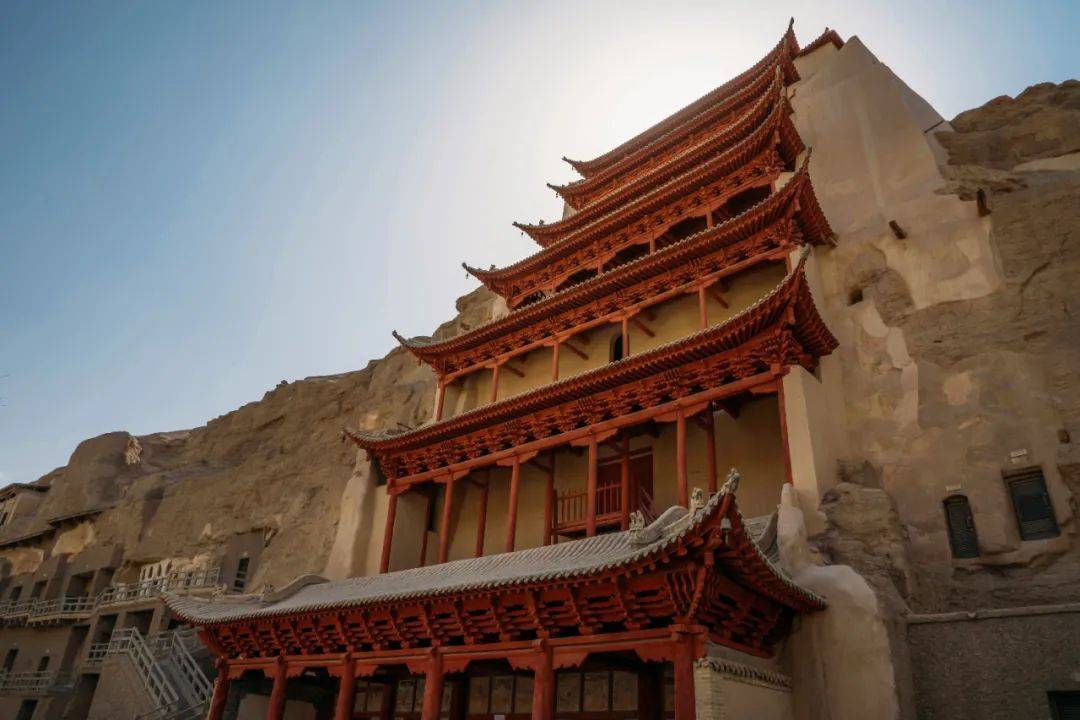
Mogao Grottoes
Desert Fortresses with No One Around: Yangguan and Yumen Pass
The End of the Wall, the Start of Imagination
Some people think the Great Wall ends near Beijing. But it doesn’t. It just gets quieter. And flatter. When I stood facing the remains of Yumen Pass—wind slicing across the plain, sand hitting my ankles—I realized this was where the wall gave way to the unknown. No dramatic gates, no crowds. Just silence and a cracked stone arch that barely stands, but somehow still commands respect.
There’s a plaque nearby, but I didn’t really read it. The view told me more: a road stretching to nowhere, a fence to stop you from getting too close, and a small wooden tower that might be newer than it looks. You feel exposed here. Like the ancient guards must have felt. It’s not about what you see—it’s about what you imagine. How far someone had to ride from here to reach Turpan. Or Samarkand. Or home.
The dust kicked up as I walked back to the car. It got in my teeth, my socks, my phone case. But that gritty feeling somehow matched the mood. It’s not a site you visit for photos—it’s one that lingers in the back of your throat.
Beyond Yangguan’s empty gates, the desert keeps another secret — Yarkhoto in Xinjiang: The 2,300-Year-Old Silk Road Fortress Carved into China’s Desert Plateau.
Poems, Wind, and That Strange Vineyard in the Sand
Yangguan is different. Rebuilt, clean paths, even a little museum. At first, I rolled my eyes—until I saw the poem. There’s a stele here with Wang Wei’s “Farewell at Yangguan” etched into it, and someone was softly reading it aloud in Mandarin when I arrived. It didn’t matter that I only caught pieces of it—I could feel it. The words floated across the wind like regret.
But then comes the twist: just beyond the monument, there’s a real vineyard. Grapes. In the Gobi. I asked our driver if they were decorative—he laughed and said no, “the best raisins in all Gansu.” The soil’s dry, the sun is relentless, but somehow these vines thrive. Locals sell raisin snacks and chilled grape juice in plastic cups. It felt surreal, sitting in the desert sipping juice that could’ve come from Italy.
There was a kid riding a donkey cart near the edge of the vines, just looping the rows like he had nowhere else to be. I stayed longer than I planned—half because of the breeze, half because I didn’t want to break the spell.
Getting There Is Half the Story (And Half the Budget)
If you want to visit both Yumen and Yangguan in one day, you’ll need to hire a driver. No public buses go all the way out. I paid ¥350 for a half-day trip, booked via the hotel (they used a private local service, not DiDi). It’s about 70km one way, and the road out there—especially toward Yadan Geopark—is scenic in a stark, desolate kind of way.
Expect military checkpoints. My passport was checked twice, and our driver had to explain I wasn’t a journalist. It wasn’t hostile, just… awkward. Don’t bring drones. Don’t joke around with your phone. Signal drops in some parts, and no one’s going to come find you if you’re stuck.
But honestly? That drive was part of what made it memorable. The landscape kept shifting: sand, gravel, wind turbines, random cows. And when you finally see that lonely stone gate in the sand, it feels earned. It feels like arriving at the edge of something ancient—and walking back into it, just for an afternoon.
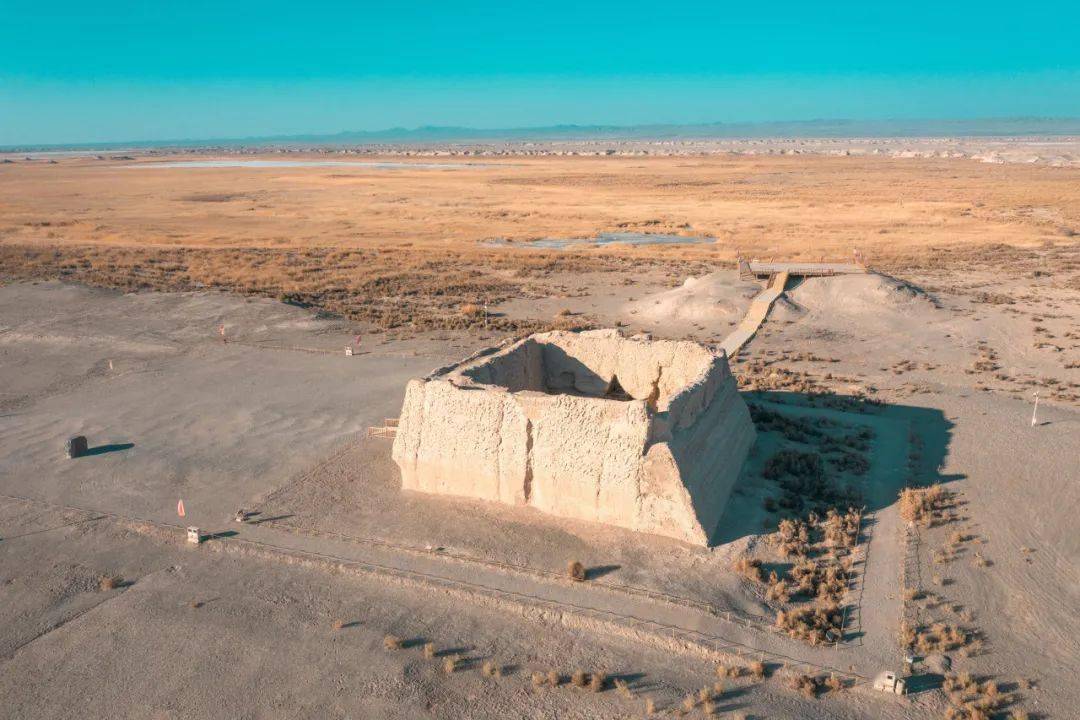
Yumen Pass
Mingsha Dunes and Crescent Spring: Real or Tourist Trap?
The Sound of Sand Isn’t a Legend—But It’s Not What You Think
I’d heard about the singing sand. Some say the dunes literally hum when the wind hits them right. That sounded… poetic. Maybe too poetic. But the name “Mingsha Shan” means “Echoing-Sand Mountain,” so I figured I’d go and see (or hear) for myself.
The ticket was ¥110, bought on Ctrip, and you’ll need your passport. They scan it at the gate. Once inside, it’s not silence you notice first—it’s noise. Loudspeakers, camel bells, vendors yelling about goggles and shoe covers. It’s Disneyland in a desert robe. I almost turned back.
But I kept walking. Past the camel line. Past the parasol crowd. Found a slope where no one else was climbing. Took off my shoes, started up barefoot. Not easy. The sand slides with each step, warm but not burning, soft but strangely sticky. And then, about halfway up—I heard it. A kind of low vibration, like rubbing your finger on a balloon, but deeper. Not music, more like friction given voice. It didn’t last long, maybe 10 seconds. But it was real.
Camels, Helicopters, and That Steep Dune Everyone Climbs
Let’s talk about the camels. Yes, they’re photogenic. No, I didn’t ride one. They’re roped together five at a time, guided in loops for the crowd. Some looked tired. Some looked bored. None looked thrilled. A kid behind me said, “They smell like my uncle’s farm,” and… fair. The experience felt performative, like the animals knew this wasn’t their desert anymore.
Instead, I watched people climb the tallest dune near the crescent. There’s a rope line you can hold, and almost everyone stops halfway, out of breath. I made it to the top. It took maybe 25 minutes. The view? Gobi in one direction, glowing water in the other. I sat down and let the wind hit my face. The Crescent Spring really is that shape—like someone pressed a bowl into wet clay. At sunset, it glows faintly blue.
Some were lining up for the helicopter ride (¥980 for a 5-minute loop). It’s loud, fast, and over before your phone adjusts focus. I didn’t take it. The view from the sand felt enough. Maybe better.
If You Go Before Sunset, Take Off Your Shoes
This might sound obvious, but no one told me: you should absolutely take your shoes off before climbing. Not because it’s spiritual. Just practical. The sand slips better that way, and there’s something strangely grounding about feeling each grain under your feet. Just keep a plastic bag for your shoes—you’ll want to put them back on fast when you come down.
Around 6:45 p.m., something changes. The wind softens. The shouting quiets. The guards back off a bit. I saw locals bringing out food to eat near the base of the dunes, families with kids kicking sand, an old man drinking tea from a thermos while watching the sky turn orange. Crescent Spring’s reflection in the water sharpens at that hour. It looks unreal, like someone painted it and forgot to erase the outline.
Is it touristy? Definitely. But if you find the right moment—if you let the noise pass—you’ll get why this place has drawn pilgrims, poets, and curious travelers for centuries. And if you leave with sand still stuck between your toes, don’t brush it off too fast. It kind of belongs there.
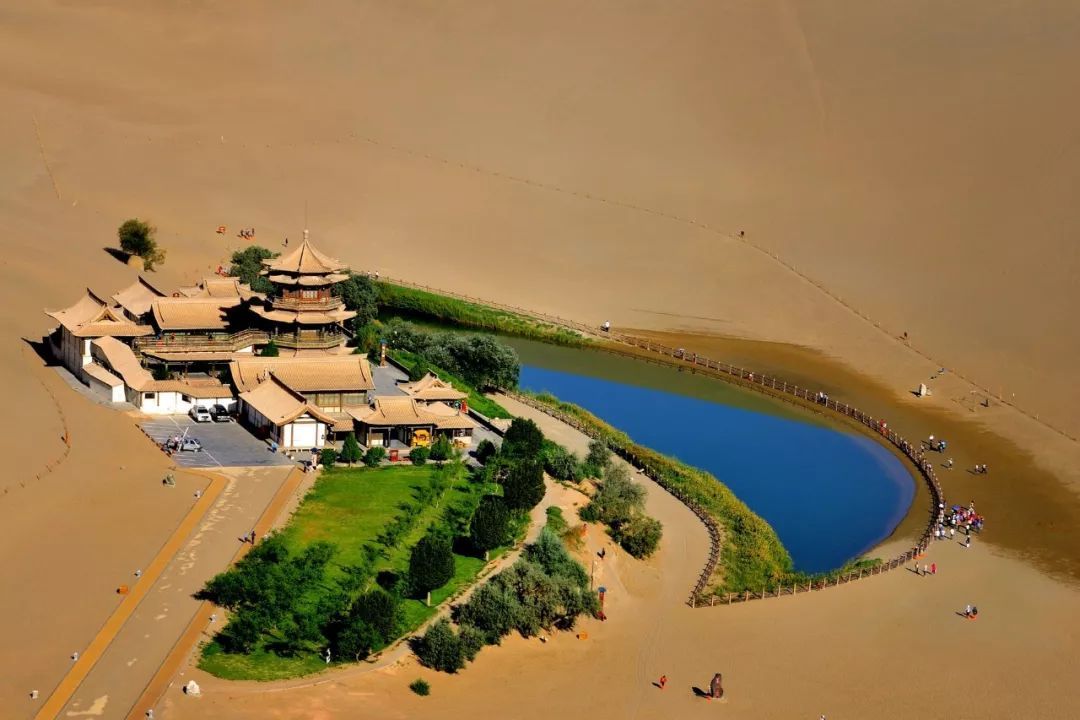
Crescent Lake
One Night in Dunhuang: Raisins, Noodles, and a Street Market Opera
Why the Best Dinner I Had Came in a Paper Bowl
You’d think that after all the desert grandeur, ancient caves, and fortress ruins, dinner would be an afterthought. But honestly? One of my favorite memories from Dunhuang happened with a ¥25 paper bowl of noodles, standing next to a plastic table behind a lantern-lit food cart.
It was near Shazhou Night Market, which comes alive around 7:30 p.m. Not just food, but local crafts, jade bracelets, and the occasional sketchy “Silk Road antique.” I walked past all that and followed my nose instead—garlic oil, cumin, and the unmistakable tingle of Sichuan pepper. The vendor didn’t speak English. I pointed. She smiled. A few minutes later, I had a bowl of lamb noodles in my hand—thick, chewy, oily in a good way. I don’t remember if I sat. I think I just stood there, eating, watching people drift past.
It was one of those moments that didn’t feel curated. No Instagram pose. No QR code menu. Just hot food, cool air, and the buzz of a city settling down after too much sun.
Watching Locals Bargain for Dried Fruit Changed My Pace
Further down the market, I saw people gathered around a stall selling raisins—not your average snack aisle kind, but massive, golden-green ones, half the size of my thumb. They were picking through them by hand, chatting with the vendor like they’d known each other for years. One woman gave me a sample. It was sweet, slightly tangy, and… dusty. Not in a bad way. Just desert-dried. Authentic.
I ended up buying half a kilo for ¥35. Did I need that much? Not really. But the vendor threw in a small bag of dried apricot slices, “gift,” he said. And just like that, I was having a different kind of travel moment—less “checklist of dunhuang china historical sites,” more “what else can I carry in my backpack?”
That shift in pace matters. You stop walking fast. You notice the kid playing with a spinning top near a fruit stand, the tea seller fanning smoke toward his kettle, the handwritten signs taped to crates: “No Taste = Don’t Pay.” Who even writes that?
The Ancient Sound of Dunhuang Show—Surprisingly Worth It
I wasn’t planning to see the show. A friend had warned me it was “cheesy,” and the ticket was ¥180 (my hotel booked it for me with a small discount). But the open-air theater was only 10 minutes from where I was staying, and the night was too clear to go back inside. I’m glad I went.
The show combines live dance, narration, shadow puppets, and—this surprised me—comedy. In Mandarin, sure, but the physical humor carried. At one point, the stage lit up with giant moving sand dunes projected on a screen behind live performers. A silk dancer spun slowly, suspended in midair, mimicking the flow of desert wind. A monk-actor read sutras in a booming chant that gave me chills.
It wasn’t perfect. The storyline was loose. The lights were a little much. But when the music swelled and the performers bowed under a starry sky, I felt something I hadn’t expected: pride. Like Dunhuang was telling its own story, and I was lucky enough to catch one version of it. If you ask me whether you should go? I won’t say yes. I’ll just say I would’ve missed something if I hadn’t.

Dunhuang raisins
What No One Mentions About Dunhuang
Military Checkpoints and VPNs (And How to Not Panic)
No one really talks about the military presence until you're already halfway into the desert. It’s not aggressive—but it’s very real. On the way to Yumen Pass and Yadan Geopark, our car got stopped at two checkpoints. The driver rolled down his window, handed over his ID. Then they looked at me. A uniformed officer stepped up, asked for my passport in clear Mandarin. I handed it over. He flipped through the pages slowly, then asked (still in Chinese), “Why are you here?” My driver stepped in, explained I was just a tourist. After a brief pause, the officer nodded and waved us on. No smile. No explanation.
It’s uncomfortable if you’re not ready for it. But it’s routine. You don’t need to overthink it—just keep your passport on you at all times, and don’t joke about drones or GPS. Speaking of which: drones are absolutely banned near anything west of the city center. Even trying to unpack one can raise questions you don’t want to answer.
And about VPNs—yes, you need one. And ExpressVPN and NordVPN weren’t working for me in Dunhuang. I had better luck with a lesser-known one called V2RayNG (set up in advance). Without it, you’re offline. Even Trip.com pages sometimes don’t load properly.
Drones, Restrictions, and That “No English” Moment at the Museum
I brought a drone on this trip. Dumb idea. Not only could I not use it legally, but just carrying it made things trickier. One checkpoint guard asked me to open my backpack and took it out. “No fly,” he said. “Sensitive area.” That was it. He didn’t confiscate it—but the message was clear. I left it in the hotel room the rest of the trip.
Inside the Dunhuang Museum, things were smoother. Entrance was free, but most labels were only in Chinese. There’s a small Silk Road exhibit, with ancient coins and painted pottery that clearly matter—but you’ll have to guess why. One hall had a 1:1 replica of a cave, which was visually striking, but again, no English signage. I stood next to a couple from France who were flipping through Google Translate in frustration. It was kind of funny, until it wasn’t.
Some displays had QR codes. Those worked if you had signal. Mine didn’t. There’s public Wi-Fi, but you need a Chinese number to register. So... yeah. Bring a local SIM or a working eSIM. And some patience.
Tips from Other Foreigners I Met—And What I’d Do Differently
At the hostel café near the bus station, I met a solo traveler from the Netherlands and a couple from Indonesia. We compared notes. Everyone had the same two regrets: not booking Mogao earlier, and underestimating how remote Dunhuang actually feels.
One tip they gave me: buy bottled water in the morning, because by noon many shops close or run out (especially during hot season). Another: get local raisins from the market, not airport gift shops. They’re cheaper and better. If I were doing it again, I’d do three things differently:
Book all tickets (especially Mogao and Yadan) at least three days ahead.
Learn ten survival Mandarin phrases, especially “I have a reservation” and “Can you scan my passport?”
Travel with cash. A lot of places still don’t accept foreign cards, and WeChat Pay with a Visa card works only in big venues, not small teashops or taxis.
Would I go again? Yes. But next time, I’d plan with the understanding that Dunhuang isn’t just historical—it’s logistically stuck halfway between the past and present. That’s part of the charm. And also, the challenge.
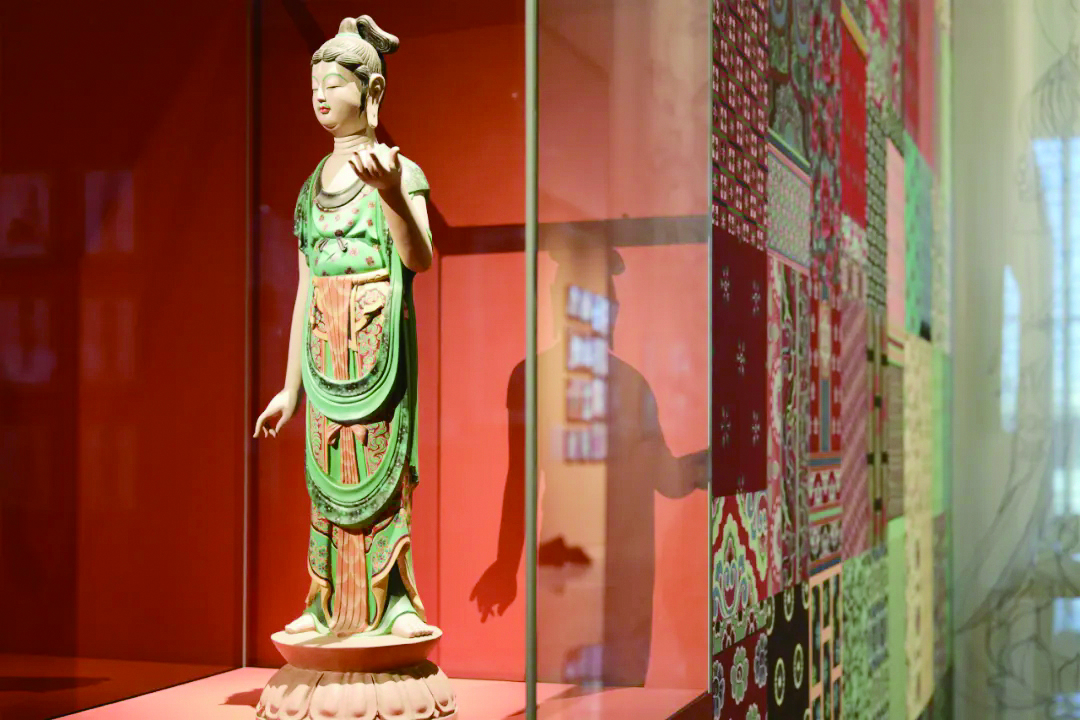
Dunhuang Museum
Before You Go: My Quick Guide for First-Time Travelers
When to Visit (And When You’ll Melt)
Dunhuang is a desert town, which means you really need to time it right—or suffer. I went in late May, and by noon, the ground was hot enough to make the soles of my shoes feel soft. Locals told me April to early June and mid-September to October are the best windows. The mornings are crisp, afternoons warm, and evenings breezy enough to walk without breaking a sweat.
Avoid the first week of October—that’s China’s National Day Golden Week. Hotels double prices, Mogao Caves sell out, and tour buses clog the roads like it’s rush hour in the Sahara. In July and August, the sun doesn’t just burn—it bakes. You won’t find shade unless you count your own shadow. One guy at the night market told me, “Even the camels go on strike.”
So if your dates are flexible, aim for shoulder seasons. Pack sunscreen, lip balm, and a scarf. Not for fashion—for dust. It gets in your ears, your water bottle, even your phone speaker. You’ll want something to wrap around your face when the wind picks up.
Where to Sleep Near the Sights (Not Just Booking.com Picks)
Here’s something you’ll only find out once you’re there: not all hotels listed online accept foreign passports. I learned that the hard way after getting rejected at check-in at a place that looked perfectly nice on Trip.com. They politely told me “no registration system for foreigners.” What they meant was: they didn’t want the extra paperwork.
The good news? A few solid places near key sites do accept foreign travelers. I stayed at Tianrun Xiangcheng Hotel near the Dunhuang Theater—walkable to both the night market and shuttle stop to Mingsha Dunes. Clean rooms, soft beds, no English, but they were used to tourists.
Others I heard good things about:
- The Silk Road Dunhuang Hotel (close to Crescent Spring, accepts foreign cards)
- Dunhuang International Youth Hostel (cheap, chill, helpful staff with basic English)
Getting to Dunhuang from Xi’an, Beijing, or Lanzhou—Without the Headache
You’ve got three real options: train, plane, or private driver (if you’re already in Gansu). Here’s the breakdown:
- By train: High-speed rail reaches Dunhuang via Lanzhou and Jiayuguan. The ride from Lanzhou takes about 8–10 hours, depending on the route. It’s scenic—expect endless desert and the occasional wind turbine—but long. I booked via Trip.com, seat was ¥260, soft seat class. Bring snacks. The dining car’s noodles taste like cardboard.
- By plane: Dunhuang Airport (DNH) connects to Xi’an, Chengdu, and Beijing. I flew in from Xi’an in just under 2 hours, cost me around ¥450 one-way with China Eastern. Flights are reliable, but bring a screenshot of your itinerary. Airport signage is minimal and English isn’t guaranteed.
- By car: Some hostels offer shared rides to places like Zhangye or the Rainbow Mountains. It sounds romantic—desert road trip!—but the roads are long, gas stations sparse, and Wi-Fi nonexistent.
Bonus tip: once you're in town, don’t rely on DiDi. It’s spotty. Local drivers can be arranged through your hotel, and they’re usually more helpful than any app.
Frequently Asked Questions (FAQs)
Q: Can foreigners visit all historical sites in Dunhuang without restrictions?
Most sites are open to foreigners, including Mogao Caves, Yumen Pass, and Mingsha Dunes. But areas near the western desert (like Yadan Geopark) may have military checkpoints, and you must carry your passport. I got checked twice—nothing dramatic, but if you forget your ID, they won’t let you through.
Q: Is English spoken at hotels, museums, or tourist sites?
Rarely. Larger hotels might have one staff member with basic English, but most places (especially ticket counters and markets) don’t. I recommend downloading Pleco or Baidu Translate and learning phrases like “I have a reservation” and “Can I pay by card?”
Q: Can I use foreign credit cards or mobile payments in Dunhuang?
Some hotels and larger attractions accept Visa/MasterCard, but night markets and local drivers don’t. You can link your foreign card to Alipay or WeChat Pay, but it’s not always accepted in smaller shops. Cash is still king in Dunhuang—bring enough.
Q: What’s the best way to book Mogao Caves tickets as a foreigner?
Use Trip.com, or ask your hotel to help you book via WeChat. Tickets often sell out 2–3 days in advance, especially during holidays. Avoid same-day plans—it almost never works.
Q: Is it safe to travel alone in Dunhuang?
Yes. I traveled solo and felt very safe, even at night. Locals are curious but not pushy. Just be aware of limited signal outside the city and carry offline maps or printed addresses if heading toward desert sites.
Q: How many days do I need in Dunhuang?
I’d recommend 3 full days: one for Mogao and city sites, one for the desert forts, and one for Mingsha Dunes and Crescent Spring. If you have a fourth, use it to visit Yadan or chill at the market.
Q: Can I use a drone or take professional photos?
Drones are banned at all major sites, especially around Mogao, Yangguan, and near military areas. Even for personal use, bringing a drone may cause problems at checkpoints. Inside the caves, photography is not allowed.
Q: What’s the internet situation like in Dunhuang?
Without a working VPN, most Western apps won’t load (Google, Instagram, even Gmail). ExpressVPN didn’t work for me. I used a shadow proxy (V2Ray) with some success. Consider installing Chinese alternatives (like Baidu Maps) before arriving.
